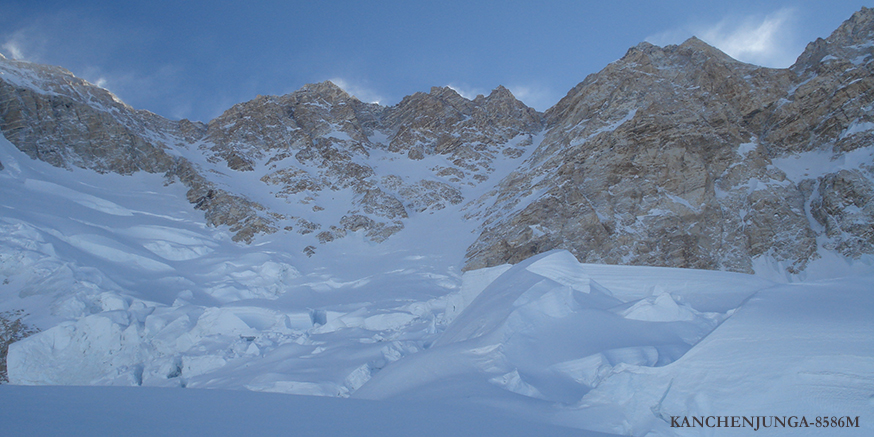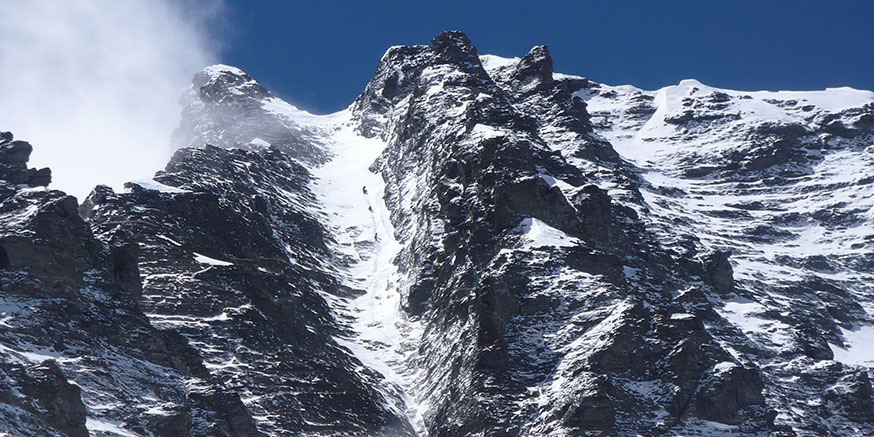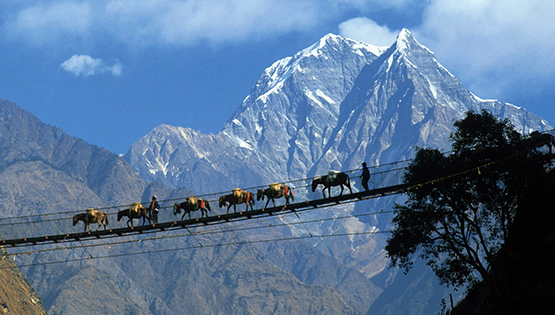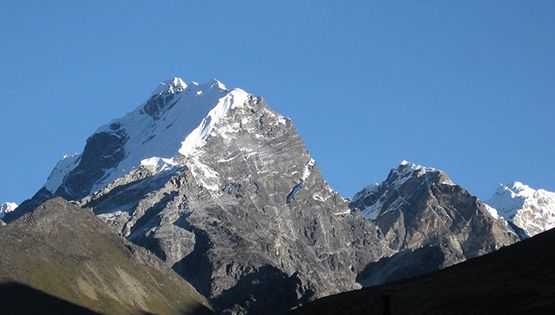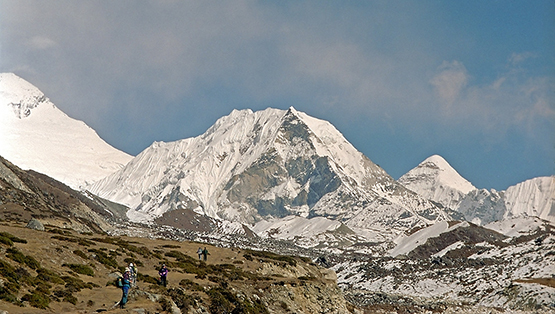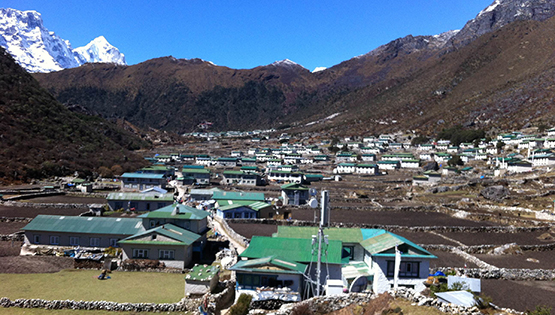Kanchenjunga in the Himalayan Range, is the third highest mountain in the world (after Mount Everest and K2), with an elevation of 8,586 metres (28,169 ft.). Kanchenjunga translated means "The Five Treasures of Snows", as it contains five peaks, four of them over 8,450 metres. The treasures represent the five repositories of God, which are gold, silver, gems, grain, and holy books. Kanchenjunga is called Sewalungma in the local Limbu language, translates as 'Mountain that we offer Greetings to'. Kanchenjunga or Sewalungma is considered sacred in the Kirant religion.Three of the five peaks (main, central, and south) are on the border of North Sikkim district of Sikkim, India and Taplejung District of Nepal, while the other two are completely in Taplejung District. Nepal is home to the Kanchenjunga Conservation Area Project run by the World Wildlife Fund in association with Government of Nepal. The sanctuary is home to the Red Panda and other montage animals, birds and plants. India's side of Kanchenjunga also has a protected park area called the Khangchendzonga National Park.Until 1852, Kanchenjunga was assumed to be the highest mountain in the world, but calculations made by the British Great Trigonometric Survey in 1849 came to the conclusion that Mount Everest (known as Peak XV at the time) was the highest and Kanchenjunga the third-highest. Kanchenjunga was first climbed on May 25, 1955 by Joe Brown and George Band, who were part of a British expedition. The British expedition honored the beliefs of the Sikkimese, who hold the summit sacred, by stopping a few feet short of the actual summit. Most successful summit parties since then have followed this tradition.The name Kangchenjunga is derived from Sanskrit kanchana ganga: kanchana means gold and ganga is the river which flows in the region. The river shines like gold and hence the name Kanchana Ganga was given to this mountain.
A very warm welcome to the Kingdom of Himalayas. Upon your arrival at the Tribhuvan international airport our representative welcomes you and assists you transfer in your hotel in Kathmandu. After time to get refreshed, evening you'll meet and transfer for welcome dinner in one of the typical Nepalese restaurant in the heart of Kathmandu i.e. Utsav or Nepali Chula (Kitchen). Here you will not simply experience the traditional Nepalese dish but will be entertained with Nepalese traditional dance and folk songs. After the dinner, you will be transferred back to your respective hotel.
Preparation for Kanchenjunga Expedition; the leader has to attend a formal briefing in the Ministry of Tourism. The day will also be for finalizing official procedure and other necessary arrangements. You will be also briefed on the nature of expedition, equipment and team composition. You can also make your last minute buying of personal items as you will be flying to the Himalayas day after tomorrow. In the late afternoon, the leader will check everyone's equipment, as Kathmandu is the last opportunity to buy anything missing. You will also get introduced with fellow expedition members and guides. Overnight at Hotel.
Kathmandu is the historical and cultural heart of Nepal and has been a popular destination for tourists ever since Nepal opened its doors to visitors. The city presents a wonderful mix of Hinduism, Tibetan Buddhism and Western influence in the Valley. Bauddhanath: Stupa with its 130 ft. dome. One of the world's largest Stupa, Bouddha is generally acknowledged to be the most important Tibetan Buddhist monument outside Tibet. Pupshupatinath Temple: Pashupatinath is considered one of the holiest shrines of all the Hindu temples. The temple has remained the presiding deity of ruling Nepalese Royalty. Swayambhunath: Three kilometres west of Kathmandu city complex locates the one of the world's most glorious Buddhist Stupas, it is said to be 2000 years old. Visitors often call it "Monkey Temple". -After the city tour, our leader or guide will do the final briefing of the expedition. They will also take the opportunity to check the members' personal equipment as the city bazaars and climbing shops will provide the last chance to correct any deficiencies. Overnight at Hotel.
It takes around 45 minutes to reach Bhadrapur from Kathmandu. Early flight will give us plenty of time to drive to Ilam, a distance of 95.5 km, which takes four hours in a private vehicle. Overnight at a lodge there with breakfast the next day.
- Mt. Kanchenjunga climbing permit from South face (Normal route)
- (4) Night hotel accommodation in Kathmandu in a 4 star category hotel, room on twin sharing basis, breakfast is included.
- Return domestic air ticket Kathmandu-Bhadrapur-Kathmandu.
- Excess baggage and domestic airport taxes.
- Necessary number of porters and yak/mules to carry the Expedition loads
- Liaison officer fee.
- Base camp manager.
- One Sherpa climbing guide/Sirdar who already climbed Kanchenjunga or 8000m peaks
- 4 Litre capacity New Brand SUMMIT Oxygen 5 bottles for each clients and 3 bottles for the climbing Sherpa (only for use).
- New Brand SUMMIT Mask and Regulator set.
- Well trained Nepali Cook and kitchen boys at Base Camp
- Climbing Sherpa (1:1 ratio) especially on summit day. This will several times multiply your safety and chances on successful summit.
- All necessary climbing hardware gear with fix rope.
- All necessary camping and kitchen gear.
- Private and individual tent at Base camp with 3 inches thick foam mattress for each member.
- Well set up double skinned group dinning tent with gas heaters and solar light inside.
- Toilet & Shower tents at BC.
- All meal & drinks at Base camp and en-route (3 times a day).
- Available high altitude food during the climbing mountain.
- All High high Altitude tents.
- Store & communication tent at BC.
- Necessary number of EPI gas with burner.
- VHF radios set to each client with radio base & accessories.
- Solar panel/generator at base camp for recharging & power supply.
- 4 Litre capacities New Brand SUMMIT 2 bottles of extra Oxygen with a set mask & regulator will be provided for medical purpose at Base camp.
- Insurance of climbing Sherpa and local team members.
- All pick up & drop transportation from airport to airport both domestic & international.
- Occasional alcoholic beverage will be provided at BC only.
- Celebration meal in Kathmandu after the expedition with all the local staffs at well reputed restaurant.
- Your International & home country domestic airfares, transfers en route & excess baggage.
- Your personal insurance. Medical, mountain rescue & repatriation cover is obligatory.
- Your personal expenses e.g. phone call, laundry, and alcohol.
- Tipping to the guide & local staffs.
- Main meals (Lunch & Dinner) in Kathmandu apart from celebration meal in Kathmandu after the trip. Allow $12-15/ meal.
- Your Nepal entry visa fee (US$125 available on entry) Valid for 90 days.
- Cost of electronic appliances.
- Cost of emergency evacuation.
- Your personal climbing gears.
- Summit bonus for your personal climbing Sherpa (Minimum is 1200>)
- Satellite phone usage is available, but at an additional cost.
- Extra night accommodation in Kathmandu because of early arrival, late departure, early return from mountain (due to any reason) than the scheduled itinerary
- Applicable permit fees & customs charges, etc for SAT Phone, communication equipment and commercial Filming Permission Fees. Need to inform us early in advance for issuing necessary permit.
| # | Start Date | End Date | Trip Cost | Availability | Booking |
|---|---|---|---|---|---|
| 1 | 9 APR 2025 | 29 MAY 2025 | USD28,500/-Per Person | Available | Book Now |
A deposit of 35% of the total trip cost is payable at the time of booking and the final balance due 8 weeks before the start of the trip. The act of booking implies that you have accepted the ethos of the trip and any objective or subjective risks associated with it.
